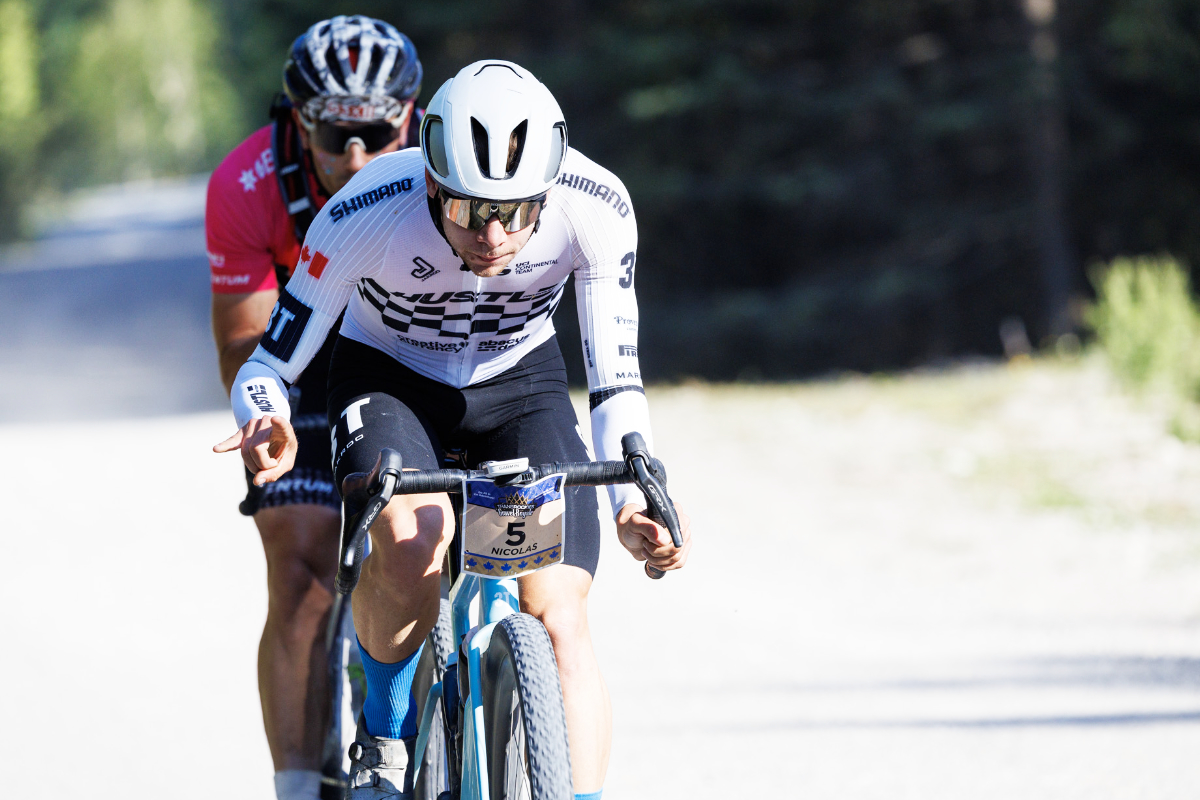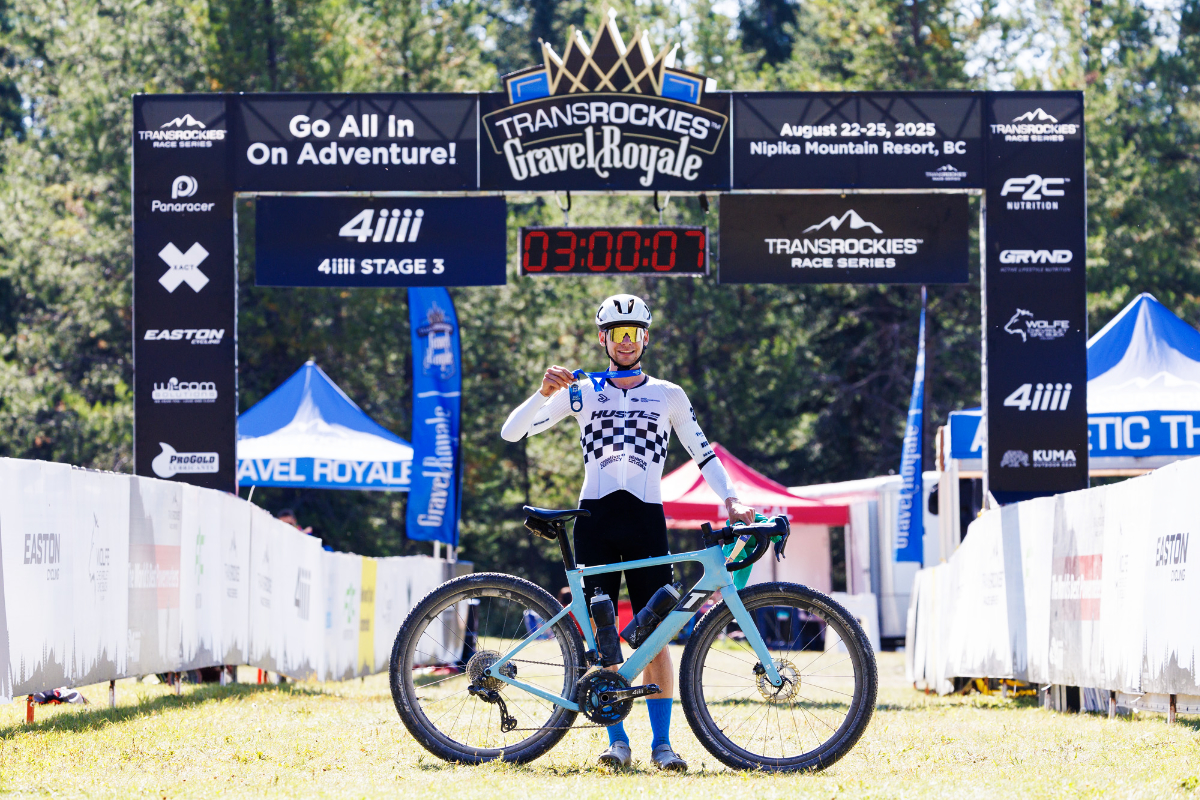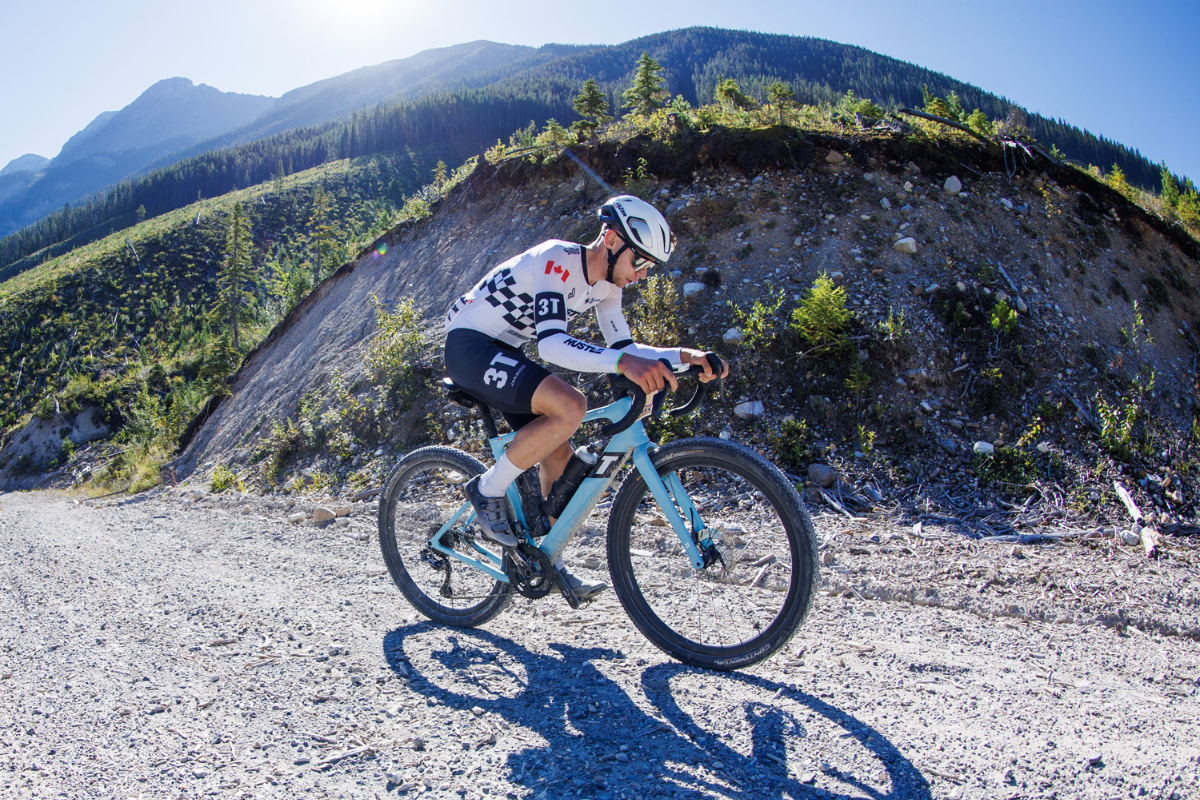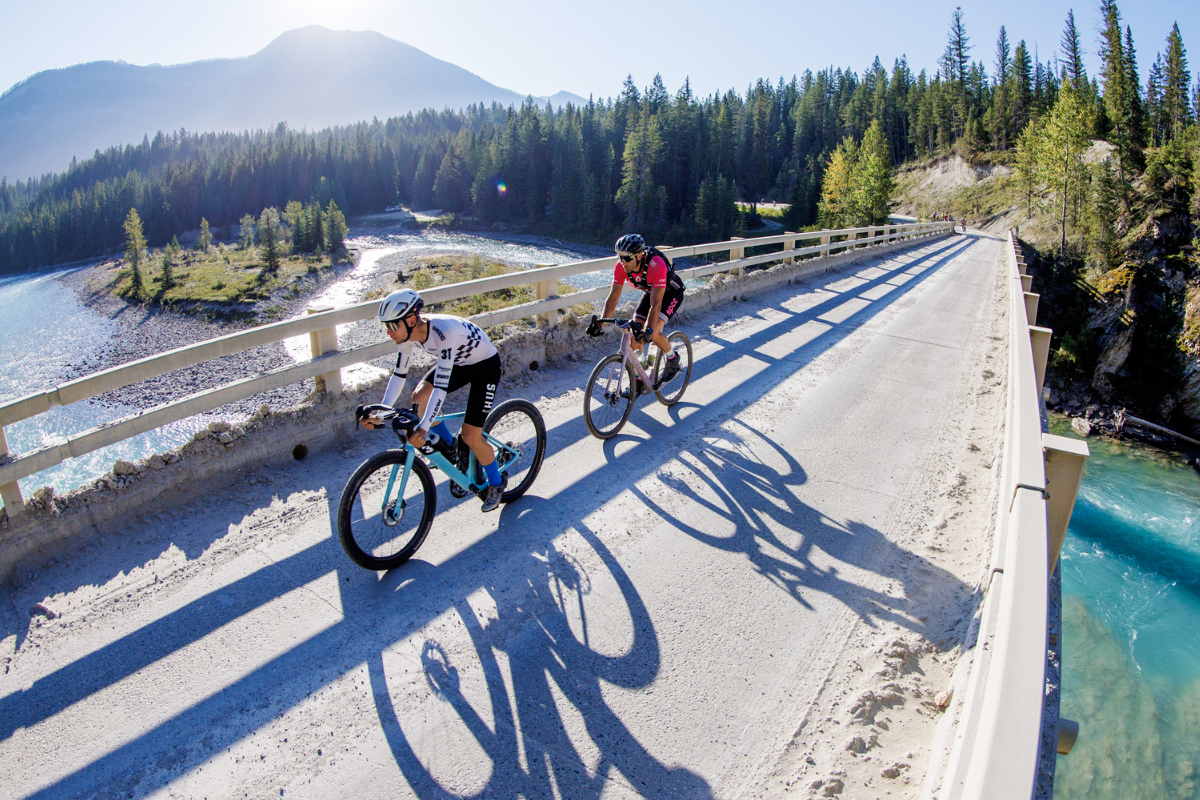The Power of Imperfect How I Prepared for TransRockies Gravel Royale
Gepostet von Nick Kleban am September 17, 2025
Nick Kleban, 4iiii athlete and multi-disciplinary racer for Toronto Hustle, recently claimed the overall victory at the final edition of the TransRockies Gravel Royale. The 3-stage gravel race, taking place in the BC interior, sent riders up, down and around some rugged Canadian terrain, testing all aspects of their cycling skill-set. Nick was kind enough to share some insights with us, in the form of a training journal, where he documented the work he put in during the weeks leading up to his strong performance. The style should look familiar to anyone who’s made the wise decision to take notes about their training, beyond the numerical stats that apps can provide, for self-reflection or to share with a coach. Check out how Nick balanced quality and quantity with “real life” demands to still achieve great results.
This year’s TransRockies went about as well as I could have imagined: three stage wins and the overall GC. The pro field wasn’t as deep as last year, but what mattered most was that my fitness had improved from 2024.
This isn’t a story of perfect prep. I’m not a pro cyclist, even if my team has “Pro” in the name. I work full-time in sports nutrition, co-run a coaching business in Montreal, and train when I can. Some days I had only 45 minutes, some days I missed completely. My goal here is transparency: to show what real preparation looks like for a self-coached athlete. Messy, imperfect, full of doubts — but ultimately effective.
A Quick Note on XERT
You’ll see me reference XERT’s “fitness signature” estimates. For context, what I’m talking about is :
Threshold power - how hard you could ride for about an hour.
Peak power - your best possible sprint.
VI (Variability Index) - a power meter metric that measures how consistent a rider’s effort is. A low VI (close to 1.0) indicates a smooth, steady effort, while a high VI suggests frequent changes in power, often due to uneven terrain or unpredictable racing conditions.
They’re estimates, not lab tests, but for someone juggling life and training, they’re useful. They let me monitor progression without wasting training days on formal testing.
Week 1: July 21–27
Monday, July 21: Rest day. Starting XERT estimates were 312w threshold and 1272w peak Power.
Tuesday, July 22 — Mardi Cycliste de Lachine: 3rd place, one hour at 261W normalized, VI 1.11. My sprint was weak at 1033W, but staying low in the wind got me to 66kph and just past Rémi Fagnan of Messorem Cycling. XERT set me at a new 315W threshold (5.3 W/kg) and 1276W peak.
Wednesday, July 23: The day after Lachine is always tough. Racing late into the evening wrecks my sleep, and I usually wake up groggy, legs heavy, and motivation low. But I dragged myself up early to get in my in-season strength session before work: deadlifts, split squats, step-ups, and core. Strength work fades in just six weeks if you stop, so even when I feel beat up, I keep the routine going — not to gain, just to hang onto what I built in the winter. After work, I rode the long way home, 59 minutes at 180 NP.
Thursday, July 24: Travel to Montana.
Friday, July 25: Pre-rode The Last Best Ride: with Andrew L’Esperance (also 4iiii-sponsored). We rode 3 hours at an easy pace, but he wanted to do a 10’ tempo interval, so I hung on so I wouldn’t get dropped. It worked out since it lined up perfectly with my own tempo zone (282W for 10’). A quiet confidence boost.
Saturday, July 26: Just an easy spin, 1.5hrs at NP 179W with an apple fritter stop. Normally, the day before a race, I’ll throw in some openers to “wake up the system,” but I felt flat and skipped them. I couldn’t tell if I was coming down with something or just tired. My best guess was the week of work stress had caught up with me. It reminded me of being back in university: I could grind through exams no problem, but the day the last one was done, I’d immediately crash or get sick. Taking Thursday / Friday off work to travel to this race felt the same as that.
Sunday, July 27 — The Last Best Ride: I woke up still unsure if I was sick or just run-down, but the gun went off, and the body didn’t lie. I was struggling almost immediately, and dropping a chain early didn’t help. I lost contact with the front group and had to claw my way back with fellow 3T athlete Drew Cummins to rejoin the lead group of eight. But when the road tilted up into the ski resort climb, the elastic snapped. I cracked hard, got dropped, and spent the rest of the day fighting myself just to get to the finish. Five hours later — 300 TSS and 4000kj in the legs — I rolled across the line in 8th place, nearly 20 minutes behind winner Adam Roberge. I got absolutely smashed!!

Balancing training and “real life” is as much a skill as on-bike technique, and one that Nick has fine-tuned.
Week 2: July 28–Aug 3
Monday, July 28: At 3 a.m., my friend Dan Walker from 3T drove me to the airport for my early morning flight. From there, it was straight off the plane into back-to-back meetings in Toronto for work. Between the travel and the meetings, there was no chance to ride that day, though even if I could have, I wouldn’t have. I was wrecked!
Tuesday, July 29: This was the fork in the road. After Whitefish, the debate in my head was simple: rest, assuming I was just fatigued, or double down, assuming I wasn’t fit enough. As a coach, I know the danger here: if it really was stress-related fatigue, doubling down on intensity could have been the worst possible move, piling damage onto a body that needed recovery. The safer play would have been to back off. But I also knew the races I was targeting — Lachine, Big Red, and TransRockies — reward the ability to surge again and again. If I wanted to close the gap to riders like Adam, I needed that repeatability. So I made the call to gamble. I risked adding a week-long HIT block rather than resting, with the hope it would sharpen me. So on this day, during the 1hr window I had in the morning, I did three sets of building on/offs:
10” at 700W / 50” Rest.
20” at 600W / 40” Rest.
30” at 540W / 30” Rest.
40” at 475W / 20” Rest.
50” at 450W / 10” Rest.
Wednesday, July 30: I only had a 45-minute window to train that day while in Toronto, so I turned it into a short-track style workout. I found a ~2.5min loop with a 90-second climb and hammered it 12 times, each lap including a 30” attack at 550–600W, mostly seated. The whole session ended up being 32 minutes at 325 NP with a VI of 1.53.
Thursday, July 31: Travel delays back home from the 6. No ride.
Friday, Aug 1: HIT block continued:
• 13×30/15 at 430W during the 30”
• 13×10” high cadence sprints with 2min recovery
• 2×6×30/15 at 430W again to finish.
I know from experience that I respond best to this on/off format. My HR climbs higher than with steady efforts, and I get more aerobic adaptation. That day I started to see signs of good form vs the two short workouts I did in Toronto which were tough. North of 400watts started to feel not horrendous.
Saturday, Aug 2: Five-hour endurance ride to Covey Hill with my friends Félix Fournier and Sam Ouellet, NP 205W.
Sunday, Aug 3: Five more hours with Félix. We have a Sunday tradition with the boys to race for town signs, including negative points if you jump for a non-official sign. After 13 sprints, I won 7–3 (yes math doesn’t add up due to negatives). XERT bumped my peak power to 1300W. Sorry for exposing you Félix.
Week 3: Aug 4–10
Monday, Aug 4: Easy spin with a coaching client, 1.5hrs.
Tuesday, Aug 5 — Lachine Finale: My third podium of the summer. I felt smooth, surging 30+ times over 900W, and in the final sprint, Philippe Jacob (also rides with 4iiii) only beat me by two bike lengths. Considering Philippe is usually in a completely different photograph than me, I’ll take that.
Wednesday, Aug 6: Gravel ride with friends, 2h15 at 220 NP. Focus: fast descending around Mt Royal. Fitness matters, but if you can’t handle your bike on dirt, gravel races will find you out. There’s a decisive rock garden in Big Red, so I wanted to be confident I could push there if it called for it.
Thursday, Aug 7: 1h15 easy, NP 200W.
Friday, Aug 8: Easy spin with a client.
Saturday, Aug 9 — Big Red Gravel: Two weeks after Whitefish, I felt like a different rider. From the neutral start, I was aggressive, and by 33 minutes, the lead group was down to four: Adam Roberge, Léandre Bouchard, Zorak Paillé (racing on a MTB), and me. I normalized 354W (5.9W/kg) through that initial selection. At 50km, Adam attacked, Léandre closed, and I counter-attacked with a 1148W initial burst. Zorak bridged, and we worked together until the course’s famous rock garden, where his MTB gave him the edge. I didn’t win — Zorak was gone in the rock garden and I never saw him again — but for me, this was redemption. Two weeks earlier, Adam had crushed me by 20 minutes. At Big Red, I raced toe-to-toe and proved I was closing the gap. The numbers also checked out; Final stats: 4h08, 270W avg (4.5 W/kg), 302 NP (5.0 W/kg), 387 TSS. XERT bumped me to a 323W threshold (5.4 W/kg). *note: for the first time in my life, I could not for the life of me get the official file from my head unit to the cloud, so the numbers mentioned are stuck on the device and not on Strava. Thanks, Zorak, for sharing the file.
Sunday, Aug 10: Group run with my girlfriend Katie. 6km in 43 minutes. Running humbled me more than the bike did.
Week 4: Aug 11–17
Monday–Tuesday: Wrecked. Spins under 0.40 IF.
Wednesday, Aug 13: 2hrs endurance with 4×12’ climbs at LT1 (245 watts).
Thursday, Aug 14: 2×5’ of 30/30 at 400W — just keeping the engine awake.
Friday, Aug 15: 1.5hrs at IF 0.55.
Saturday, Aug 16: Big adventure with my friend Félix Lessard: Montreal to Sutton and back, 7h15, NP 200W, 300 TSS. Faded in the heat late, but it was exactly the durability check I needed going into a stage race.
Sunday, Aug 17: 2hrs at the F1 track with my friend Adithya, NP 190W.
Race Week: Aug 18–22
Monday, Aug 18: Off (by choice).
Tuesday, Aug 19: 2hrs with one 5’ opener at 330W.
Wednesday, Aug 20: 3hrs steady at 193 NP.
Thursday, Aug 21: Missed ride — last office day before travel so I worked until late in the day.
Friday, Aug 22: Travel delays. Missed the shakeout ride. Only time for a cold pond dip. Not textbook tapering with 3 full days off the bike, but once the week is gone, you can’t get it back.
TransRockies: Aug 23–25
I raced from the gun every day, often solo in the wind. Physically, I felt strong, but the harder battle was mental: reminding myself to keep pressing, to not slip into comfort just because I had big leads. It would have been easy to ease off — but I had trained expecting a fight like last year, and I wanted to prove to myself that the work I’d put in was real. And it was. Each stage my climbing was 5–10% faster than in 2024. Sure, equipment upgrades played a role, but the bigger difference was in me. The gamble I’d taken in training had paid off, and I could finally see the proof in my racing.
The Lesson
Roger Federer once pointed out that over his entire career he only won 54% of the points he played — yet he still won nearly 80% of his matches. That stuck with me because it captures the reality of being a self-coached rider who also has another life outside of training. You don’t need perfection to succeed. You just need to win enough of the right “points” — the key workouts, the key moments, the key decisions to push on vs back off. That’s the bigger picture. Your training will always look flawed up close; missed sessions, 45-minute quickies between meetings, fatigue, and plenty of self-doubt. But if you keep showing up, and trusting that messy progress adds up, you’ll be amazed at how different the story looks when you step back.
Keep up to date with Nick’s racing: Instagram
Book Nick for coaching: Toguri
Check out the training tools Nick uses to guide his powerful form: 4iiii.





